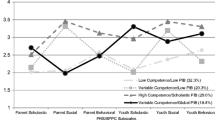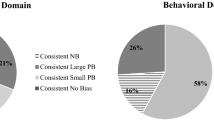Abstract
It has been claimed that excessively positive self-perceptions of competence are a key risk factor for concurrent and subsequent impairments in youth with attention-deficit/ hyperactivity disorder (ADHD). We examined whether girls with ADHD demonstrate positive illusory self-perceptions in scholastic competence, social acceptance, and behavioral conduct domains. We then tested, across a five-year longitudinal span, whether (a) such self-perceptions versus (b) the constituent informant ratings or test scores were more strongly predictive of adolescent impairment and positive adjustment. Participants included an ethnically diverse sample of 140 girls with ADHD and 88 comparison girls, aged 6–12 at baseline (M = 9.0, SD = 1.7). Girls with ADHD rated themselves as more positive than indicated by external ratings, but these self-reports were still in a negative direction (comparison girls rated themselves as less positive than these indicators). ADHD subtypes were not related to discrepancy scores. Higher rates of depression symptoms were associated with attenuated discrepancy scores. Crucially, measures of actual competence were more strongly associated with adolescent impairment and positive adjustment than were “illusory” self-perceptions for girls with ADHD. Our findings challenge the view that, at least in girls with ADHD, overly positive and “illusory” appraisals of competence are strongly associated with future impairment and adjustment. The key psychometric point is that, in difference or discrepancy scores, the individual components of such scores should be separately examined.
Similar content being viewed by others
References
Achenbach, T. M. (1991). Manual for the child behavior checklist and revised child behavior profile. Burlington: University Associates in Psychiatry.
Achenbach, T. M., & Rescorla, L. A. (2004). The Achenbach System of Empirically Based Assessment (ASEBA) for ages 1.5 to 18 years. In M. R. Maruish (Ed.), The use of psychological testing for treatment planning and outcome assessment: Volume 2. Instruments for children and adolescents (3rd ed., pp. 179–213). Mahwah: Lawrence Erlbaum.
Alicke, M. D., & Govorun, O. (2005). The better-than-average effect. In M. D. Alicke, D. A. Dunning, & J. I. Krueger (Eds.), The self in social judgment (pp. 85–106). New York: Psychology.
American Psychiatric Association. (2000). Diagnostic and statistical manual of mental disorders (4th ed., text rev.). Washingtion, DC: Author.
Barkley, R. A. (2006). Attention-deficit hyperactivity disorder: A handbook for diagnosis and treatment (3rd ed.). New York: Guilford.
Barkley, R. A., Murphy, K. M., & Fischer, M. (2008). ADHD in adults: What the science says. New York: Guilford.
Baumeister, R. F., Bratslavsky, E., Finkenauer, C., & Vohs, K. D. (2001). Bad is stronger than good. Review of General Psychology, 5(4), 323–370. doi:10.1037/1089-2680.5.4.323.
Bird, H. R. (1999). The assessment of functional impairment. In D. Shaffer, C. P. Lucas, & J. E. Richters (Eds.), Diagnostic assessment in child and adolescent psychopathology (pp. 209–229). New York: Guilford.
Blachman, D., & Hinshaw, S. P. (2002). Patterns of friendship among girls with and without attention-deficit/hyperactivity disorder. Journal of Abnormal Child Psychology, 30(6), 625–640. doi:10.1023/A:1020815814973.
Cohen, J., Cohen, P., West, S. G., & Aiken, L. (2003). Applied multiple regression/correlation analyses for the behavioral sciences (3rd ed.). Mahwah: Erlbaum.
Cronbach, L. J., & Furby, L. (1970). How we should measure “change” – or should we? Psychological Bulletin, 74(1), 68–80. doi:10.1037/h0029382.
De Los Reyes, A., & Kazdin, A. E. (2004). Measuring informant discrepancies in clinical child research. Psychological Assessment, 16, 330–334. doi:10.1037/1040-3590.16.3.330.
Dishion, T. J., & Kavanagh, K. (2003). Intervening in adolescent problem behavior: A family-centered approach. New York: Guilford.
Edwards, J. R. (2001). Ten difference score myths. Organizational Research Methods, 4, 265–287. doi:10.1177/109442810143005.
Evangelista, N. M., Owens, J. S., Golden, C. M., & Pelham, W. E. (2008). The positive illusory bias: do inflated self-perceptions in children with ADHD generalize to perceptions of others? Journal of Abnormal Child Psychology, 36, 779–791. doi:10.1007/s10802-007-9210-8.
Gresham, F. M., MacMillan, D. L., Bocian, K. M., Ward, S. L., & Forness, S. R. (1998). Comorbidity of hyperactivity-impulsivity-inattention and conduct problems: risk factors in social, affective and academic domains. Journal of Abnormal Child Psychology, 26, 393–406. doi:10.1023/A:1021908024028.
Griffin, D., Murray, S., & Gonzalez, R. (1999). Difference score correlations in relationship research: a conceptual primer. Personal Relationships, 6, 505–518. doi:10.1111/j.1475-6811.1999.tb00206.x.
Harter, S. (1982). The perceived competence scale for children. Child Development, 53, 87–97. doi:10.2307/1129640.
Harter, S. (1985). Manual for the Self-Perception Profile for Children. Unpublished manuscript, University of Denver, CO.
Hinshaw, S. P. (2002). Preadolescent girls with attention-deficit/hyperactivity disorder: I. Background characteristics, comorbidity, cognitive and social functioning, and parenting practices. Journal of Consulting and Clinical Psychology, 70(5), 1086–1098. doi:10.1037/0022-006X.70.5.1086.
Hinshaw, S. P., Owens, E. B., Sami, N., & Fargeon, S. (2006). Prospective follow-up of girls with attention-deficit/hyperactivity disorder into adolescence: evidence for continuing cross-domain impairment. Journal of Consulting and Clinical Psychology, 74(3), 489–499. doi:10.1037/0022-006X.74.3.489.
Hinshaw, S. P., Klein, R. G., & Abikoff, H. B. (2007). Childhood attention-deficit/hyperactivity disorder: Nonpharmacological treatments and their combination with medication. In P. E. Nathan & J. M. Gorman (Eds.), A guide to treatments that work (3rd ed., pp. 3–27). New York: Oxford University Press.
Hoza, B., Pelham, W. E., Waschbusch, D. A., Kipp, H., & Owens, J. S. (2001). Academic task persistence of normally achieving ADHD and control boys: performance, self-evaluations, and attributions. Journal of Consulting and Clinical Psychology, 69, 271–283. doi:10.1037/0022-006X.69.2.271.
Hoza, B., Pelham, W. E., Dobbs, J., Owens, J. S., & Pillow, D. R. (2002). Do boys with attention deficit/hyperactivity disorder have positive illusory self-concepts? Journal of Abnormal Psychology, 111, 268–278. doi:10.1037/0021843X.111.2.268.
Hoza, B., Gerdes, A. C., Hinshaw, S. P., Arnold, E. L., Pelham, W. E., Molina, B. S. G., et al. (2004). Self-perceptions of competence in children with ADHD and comparison children. Journal of Consulting and Clinical Psychology, 72, 382–391. doi:10.1037/0022-006X.72.3.382.
Hoza, B., Murray-Close, D., Arnold, L. E., Hinshaw, S. P., Hechtman, L., & and the MTA Cooperative Group. (2010). Time-dependent changes in positively biased self-perceptions of children with attention-deficit/hyperactivity disorder: a developmental psychopathology perspective. Development and Psychopathology, 22, 375–390. doi:10.1017/S095457941000012X.
Jacobson, N. S., & Truax, P. (1991). Clinical significance: a statistical approach to defining meaningful change in psychotherapy research. Journal of Consulting and Clinical Psychology, 59, 12–19.
Kessler, R. C., McGonagle, K. A., Swartz, M., Blazer, D. G., & Nelson, C. B. (1993). Sex and depression in the National Comorbidity Survey, I: lifetime prevalence, chronicity and recurrence. Journal of Affective Disorders, 29, 85–96. doi:10.1016/0165-0327(93)90026-G.
Kovacs, M. (1992). Children’s depression inventory (CDI) manual. Toronto: Multi-Health Systems, Inc.
Lewinsohn, P. M., Clark, G. N., Seeley, J. R., & Rhode, P. (1994). Major depression in community adolescents – age at onset, episode duration and time to recurrence. Journal of the American Academy of Child and Adolescent Psychiatry, 33, 809–818. doi:10.1097/00004583-199407000-00006.
McQuade, J. D., Hoza, B., Pelham, W. E., & Fefer, S. (2008, August). A longitudinal study of positiveillusions, depression and cognitive distortions. Paper presented at the American Psychological Association, Boston, MA.
Mikami, A. Y., & Hinshaw, S. P. (2006). Resilient adolescent adjustment among girls: buffers of childhood peer rejection and Attention-Deficit/Hyperactivity Disorder. Journal of Abnormal Child Psychology, 26, 823–837. doi:10.1007/s10802-006-9062-7.
Mikami, A. Y., Calhoun, C. D., & Abikoff, H. B. (2010). Positive illusory bias and response to behavioral treatment among children with Attention Deficit/Hyperactivity Disorder. Journal of Clinical Child and Adolescent Psychology, 39(3), 373–385. doi:10.1080/15374411003691735.
Nigg, J. T. (2006). What causes ADHD?: Understanding what goes wrong and why. New York: Guilford.
Owens, J. S., & Hoza, B. (2003). The role of inattention and hyperactivity/impulsivity in the positive illusory bias. Journal of Consulting and Clinical Psychology, 71, 680–691. doi:10.1037/0022-006X.71.4.680.
Owens, J. S., Goldfine, M. E., Evangelista, N. M., Hoza, B., & Kaiser, N. M. (2007). A critical review of self-perceptions and the positive illusory bias in children with ADHD. Clinical Child and Family Psychology Review, 10(4), 335–351. doi:10.1007/s10567-007-0027-3.
Owens, E. B., Hinshaw, S. P., Lee, S. S., & Lahey, B. B. (2009). Few girls with childhood attention-deficit/hyperactivity disorder show positive adjustment during adolescence. Journal of Clinical Child & Adolescent Psychology, 38, 132–143. doi:10.1080/15374410802575313.
Pedhazur, E. J., & Schmelkin, L. P. (1991). Measurement, design, and analysis: An integrated approach. New Jersey: Lawrence Erlbaum Associates, Inc.
Peeters, G., & Czapinski, J. (1990). Positive–negative asymmetry in evaluations: The distinction between affective and informational regativity effects. In W. Stroebe & M. Hewstone (Eds.), European review of social psychology (Vol. 1, pp. 33–60). Hoboken: Wiley.
Shaffer, D., Fisher, P., Lucas, C., Dulcan, M. K., & Schwab-Stone, M. (2000). NIMH Diagnostic Interview Schedule for Children, Version IV: description, differences from previous versions, and reliability of some common diagnoses. Journal of the American Academy of Child and Adolescent Psychiatry, 39, 28–38. doi:10.1097/00004583-200001000-00014.
Slomkowski, C., Klein, R. G., & Mannuzza, S. (1995). Is self-esteem an important outcome in hyperactive children? Journal of Abnormal Child Psychology, 23(3), 303–315. doi:10.1007/BF01447559.
Taylor, S. E., & Brown, J. D. (1988). Illusions and well-being: a social psychological perspective on mental health. Psychological Bulletin, 103, 193–210. doi:10.1037/0033-2909.103.2.193.
Toplak, M. E., Connors, L., Shuster, J., Knezevic, B., & Parks, S. (2008). Review of cognitive, cognitive-behavioral, and neural-based interventions for Attention-Deficit/Hyperactivity Disorder (ADHD). Clinical Psychology Review, 28, 801–823. doi:10.1016/j.cpr.2007.10.008.
Treuting, J. J., & Hinshaw, S. P. (2001). Depression and self-esteem in boys with attention-deficit/hyperactivity disorder: associations with comorbid aggression and explanatory attributional mechanisms. Journal of Abnormal Child Psychology, 29, 23–29. doi:10.1023/A:1005247412221.
Waschbusch, D. A., & Hill, P. G. (2003). Empirically supported, promising, and unsupported treatments for children with attention-deficit/hyperactivity disorder. In S. O. Lilienfeld, S. J. Steven, & J. M. Lohr (Eds.), Science and pseudoscience in clinical psychology (pp. 333–362). New York: Guilford. doi:10.1023/B:JOYO.0000025323.94929.d9.
Wechsler, D. (1992). Wechsler Individual Achievement Test. New York: Psychological Corporation.
Weinstein, N. D. (1980). Unrealistic optimism about future life events. Journal of Personality and Social Psychology, 39(5), 806–820. doi:10.1037/0022-3514.39.5.806.
Weinstein, N. D. (1982). Unrealistic optimism about susceptibility to health problems. Journal of Behavioral Medicine, 5(4), 441–460. doi:10.1007/BF00845372.
Author information
Authors and Affiliations
Corresponding author
Additional information
Work on this article was funded by National Institute of Mental Health Grant R01 MH45064. We thank the participating girls and their families for their commitment to our research. We gratefully acknowledge the many graduate students and research assistants who have made this project possible.
Rights and permissions
About this article
Cite this article
Swanson, E.N., Owens, E.B. & Hinshaw, S.P. Is the Positive Illusory Bias Illusory? Examining Discrepant Self-Perceptions of Competence in Girls with ADHD. J Abnorm Child Psychol 40, 987–998 (2012). https://doi.org/10.1007/s10802-012-9615-x
Published:
Issue Date:
DOI: https://doi.org/10.1007/s10802-012-9615-x




